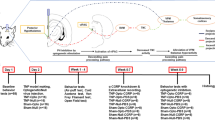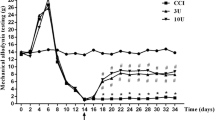Summary
This study examined the analgesic effect of diprospan in rats with trigeminal neuralgia. Rat model of trigeminal neuralgic pain was established by loosely ligating the left infraorbital branch of the trigeminal nerve. After allodynia developed, the rats were randomly divided into 2 groups (n=20 in each): diprospan group, in which the rats received diprospan (7 mg/mL, 0.1 mL) injected to the left infraorbital foramen area; control group, in which saline (0.1 mL) was administered as the same manner as the diprospan group. The pain threshold (PT) in the left infraorbital area was measured before and 2, 6, and 8 weeks after the administration. The expression of neuropeptides [substance P, preprotachykinin A (PPTA), calcitonin gene-related peptide (CGRP)] in the trigeminal nerve was detected at the same time points as the PT measurement by immunohistochemistry or in situ hybridization method. The results showed that in the diprospan group, the PT was 10.65±1.26, 10.77±1.19 and 14.13±1.34 g 2, 6, and 8 weeks after the administration respectively, significantly higher than that before the administration (PT value: 0.36±0.11) (P<0.05 for each). In the saline group, the PT was 0.37±0.13, 0.66±0.09, 4.45±1.29 and 13.72±1.72 g before and 2, 6, and 8 weeks after the administration respectively with differences being significant between before and 6, 8 weeks after the administration (P<0.01). No significant difference existed in the PT between the diprospan group and the saline group at pre-administration (P>0.05). The PT in the diprospan group was significantly greater than that in the saline group 2 and 6 weeks post-administration (P<0.05). In the diprospan group, the expression levels of neuropeptides were significantly reduced as compared with those in the saline group 2 and 6 weeks post-administration (P<0.05). It was concluded that diprospan has an obvious analgesic effect on the trigeminal neuropathic pain partly by reducing the expression of neuropeptides in the trigeminal ganglia.
Similar content being viewed by others
References
Han SR, Yeo SP, Lee MK, et al. Early dexamethasone relieves trigeminal neuropathic pain. J Dent Res, 2010,89(9):915–920
Chin TH. Trigeminal neuralgia treated with dexamethasone. Yokohama Med Bull, 1966,17(4):115–117
Liang LM, Liu CM, Hao G. Clinical study of treating primary trigeminal neuralgia of aged people by local injection of Diprospan. Chin J Geriatric Dentistry (Chinese), 2007,5(3):153–155
Wang YX, Tian YK, Guan SH, et al. A clinical study of compound betamethasone injection for treating primary trigeminal neuralgia. J Taishan Medical College (Chinese), 2010,31(1):23–25
Idänpään-Heikkilä JJ, Guilbaud G. Pharmacological studies on a rat model of trigeminal neuropathic pain: baclofen, but not carbamazepine, morphine or tricyclic antidepressants, attenuates the allodynia-like behaviour. Pain, 1999,79(2–3):281–290
Vos BP, Strassman AM, Maciewicz RJ. Behavioral evidence of trigeminal neuropathic pain following chronic constriction injury to the rat’s infraorbital nerve. J Neurosci, 1994,14(5):2708–2723
Imamura Y, Kawamoto H, Nakanishi O. Characterization of heat-hyperalgesia in an experimental trigeminal neuropathy in rats. Exp Brain Res, 1997,116(1):97–103
Anderson LC, Vakoula A, Veinote R. Inflammatory hypersensitivity in a rat model of trigeminal neuropathic pain. Arch Oral Biol, 2003,48(2):161–l69
Fromm GH, Terrence CF, Maroon JC. Trigeminal neuralgia. Current concepts regarding etiology and pathogenesis. Arch Neurol, 1984,41(11):1204–1207
Pernow B. Substance P. Pharmacol Rev, 1983,35(2):85–141
Amara SG, Jonas V, Rosenfeld MG, et al. Alternative RNA processing in calcitonin gene expression generates mRNAs encoding different polypeptide products. Nature, 1982,298(5871):240–244
Morris HR, Panico M, Etienne T, et al. Isolation and characterization of human calcitonin gene-related peptide. Nature, 1984,308(5961):746–748
Li XG, Gao DA, Jin S, et al. The level of PPTA mRNA and its proteins expression in trigeminal ganglia in rats with occlusal recovery. Shanghai J Stomatology (Chinese), 2008,17(4):411–415
Li XG, Yuan LL, Liu HJ, et al. Expressions of calcitonin gene-related peptide in rats with occlusal reconstruction. Shanghai J Stomatology, 2006,15(6):649–652
Strittmatter M, Grauer M, Isenberg E, et al. Cerebrospinal fluid neuropeptides and monoaminergic transmitters in patients with trigeminal neuralgia. Headache, 1997, 37(4):211–216
Goadsby PJ, Edvinsson L, Ekman R. Release of vasoactive peptides in the extracerebral circulation of humans and the cat during activation of the trigeminovascular system. Ann Neurol, 1988,23(2):193–196
Bouckoms AJ, Poletti CH, Sweet WH, et al. Trigeminal facial pain: a model of peptides and monoamines in intracerebral cerebrospinal fluid. Agressologie, 1991,32(5): 271–274
Marinković S, Gibo H, Todorović V, et al. Ultrastructure and immunohistochemistry of the trigeminal peripheral myelinated axons in patients with neuralgia. Clin Neurol Neurosurg, 2009,111(10):795–800
Seino H, Seo K, Maeda T, et al. Behavioural and histological observations of sensory impairment caused by tight ligation of the trigeminal nerve in mice. J Neurosci Methods, 2009,181(1):67–72
Xu M, Aita M, Chavkin C. Partial infraorbital nerve ligation as a model of trigeminal nerve injury in the mouse: behavioral, neural, and glial reactions. J Pain, 2008, 9(11):1036–1048
Xie W, Liu X, Xuan H, et al. Effect of betamethasone on neuropathic pain and cerebral expression of NF-kappaB and cytokines. Neurosci Lett, 2006,393(2–3):255–259
Zhuang CY, Cao P, Zheng T, et al. Intradiscal interventional therapy for degenerative chronic discogenic low back pain with end-plate Modic changes. Zhonghua Yi Xue Za Zhi (Chinese), 2009,89(35):2490–2494
Author information
Authors and Affiliations
Corresponding author
Additional information
This project was supported by a grant from the Science and Technique Bureau of Tai’an City (No. 2003-52).
Rights and permissions
About this article
Cite this article
Wang, Y., Li, X., Cao, L. et al. Analgesic effect of diprospan in rats with trigeminal neuralgia. J. Huazhong Univ. Sci. Technol. [Med. Sci.] 31, 395–399 (2011). https://doi.org/10.1007/s11596-011-0388-1
Received:
Published:
Issue Date:
DOI: https://doi.org/10.1007/s11596-011-0388-1




